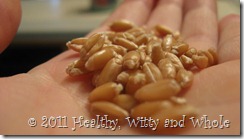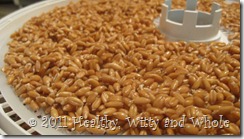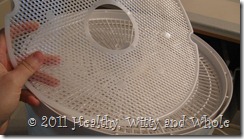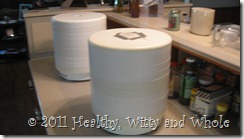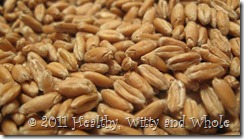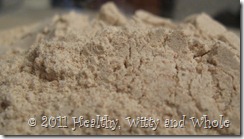I’m posting this to participate in GNOWFGLINS Simple Lives Thursday! :-)
How to Sprout Grain for Bread and Baking:
Several years ago, when I was around 17 or 18, I first attempted sprouting grain and making bread from it. A bread-baking veteran of 8 years, I knew bread making quite well, but sprouted grain was beyond me at the time and I gave it up. Last year, I started trying again. This time, I used our 2 dehydrators (we owned one and then someone gave us another one) and mesh sheets to dehydrate the grain instead of the oven. I bought some grain from To Your Health Sprouted Grain to compare with mine. I now have conquered the tricks of sprouted flour and now I am attempting a new challenge, sprouted sourdough bread. We’ll see how it turns out. I made my own sourdough starter, and so far, so good. :-)
Sprouting the grain is a some of a hassle, but well worth it. I sprout hard red wheat and it makes the softest, flavor rich loaves. Unsprouted, red wheat is dense and make small, unsavory loaves. I’m happy that it makes such a difference to sprout, since red wheat is so much more nutritious than white.
To sprout, I soak my grain in water for 12 hours. This helps gets rid of all the bacteria and enzyme inhibitors in the grain. After soaking, I drain the water and let it sprout all night. The sprouts should be barely visible, at the most an 1/8 of an inch, no more or else your bread will flop. That’s teary-eyed experience speaking. ;-)
Then, I spread the grain on my dehydrator racks that have mesh screens on them and dehydrate at least 12 hours, sometimes more like 18. The grain has to be very dry. That’s very important. I ruined a grain mill once. *ahem* *blush* Grind like normal whole grain and use for any recipe asking for flour. Because it has a little bit more moister than other flour, you will have to use a little more than you use for whole wheat flour, but about equal amounts with white flour.
Benefits of Sprouted Grain:
Why is sprouting grain so good for you? For the answer, I’ll go to the “professionals”, those who can say it much more eloquently than I could ever try to.
Kelly the Kitchen Kop says that:
“Sprouting radically changes grains by:
- Changing the composition of starch molecules, converting them into vegetable sugars, so the body recognizes and digests sprouted grains as a vegetable.
- Enzymes are created that aid digestion, complex sugars are broken down which can eliminate painful gas, and vitamin and mineral levels increase.
- Sprouting neutralizes potent carcinogens and enzyme inhibitors, as well as an acid that inhibits absorption of calcium, magnesium, iron, copper and zinc.”
Nourished Kitchen blog says: “When examining the nutrient density of sprouted wheat to unsprouted wheat on a calorie-per-calorie basis, you’ll find that sprouted wheat contains four times the amount of niacin and nearly twice the amount of vitamin B6 and folate as unsprouted wheat; moreover, it contains more protein and fewer starches than non-sprouted grain and as a further boon, it is lower on the glycemic index making it more suitable for those suffering from blood sugar issues.”
There is lots of information from To Your Health Sprouted Flour and Summers Sprouted Flour Company, which are good places to buy sprouted grain/flour if you can’t do it yourself. I’ve also heard a lot of research saying that those who are gluten-intolerant can eat sprouted flour products because of the enzymes being activated.

